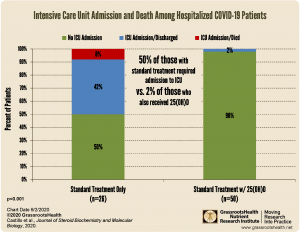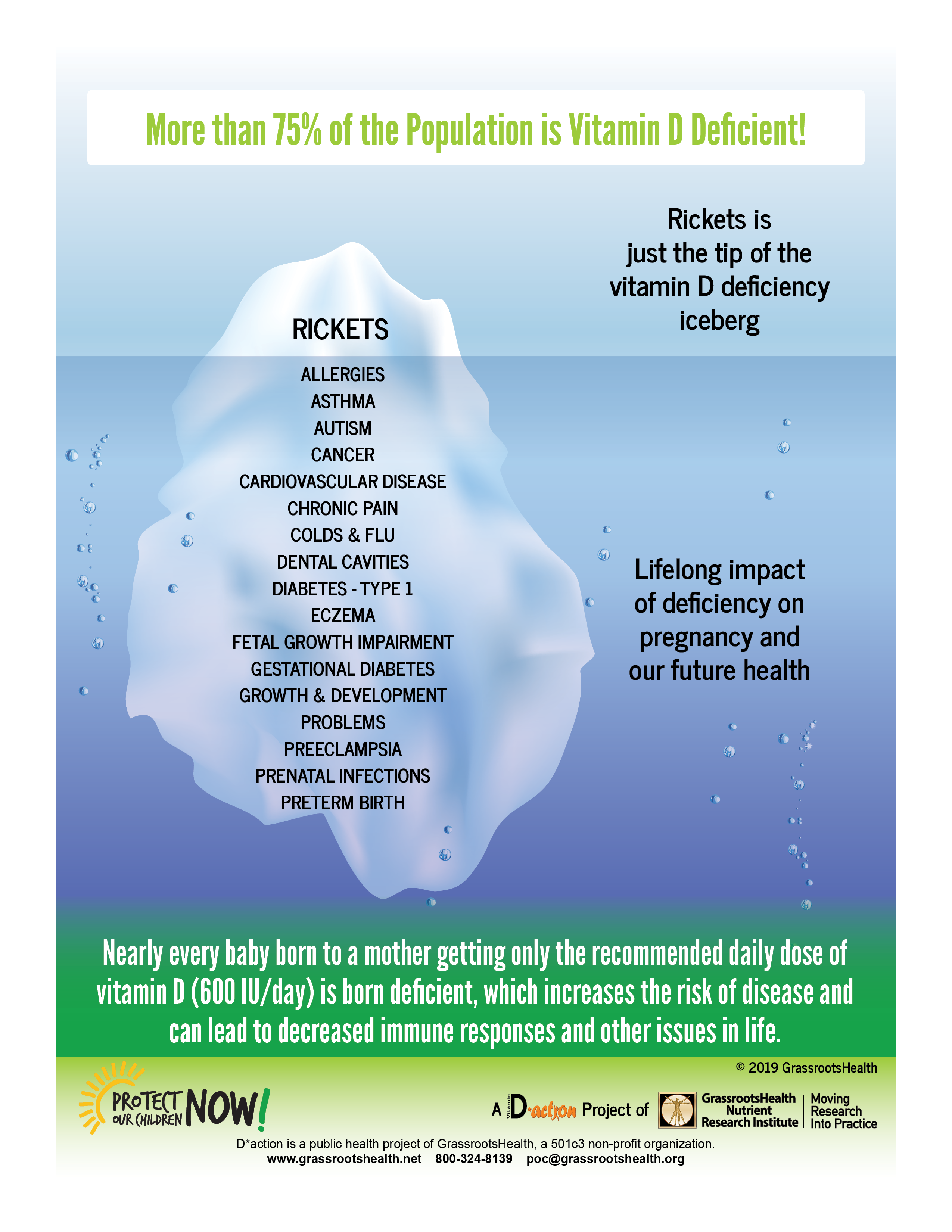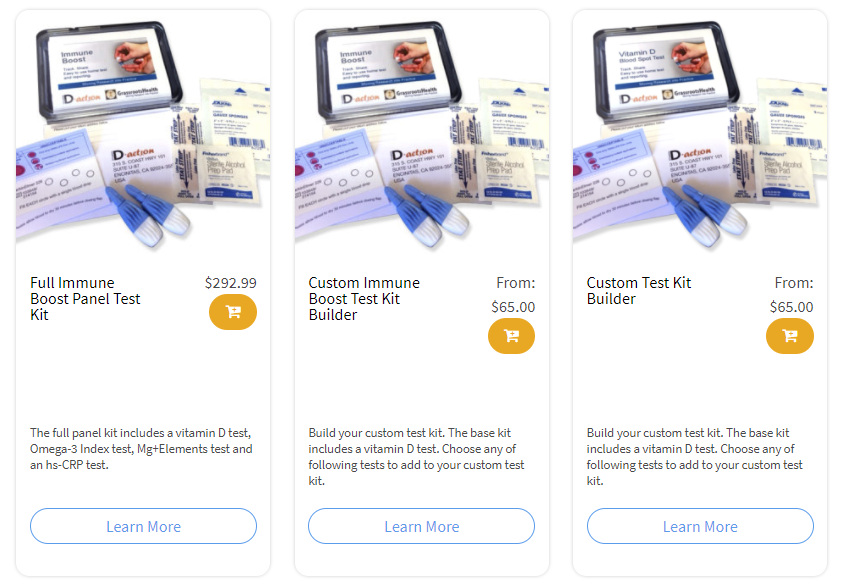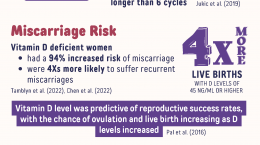Published on November 12, 2020
Why it is Important to Ensure Vitamin D Levels are 40-60 ng/ml (100-150 nmol/L) for a Healthy Pregnancy and Baby
 Pregnancy is the start of a beautiful adventure and some startlingly unique body changes. Pregnancy affects every organ system and metabolic pathway in the body. Blood volume increases, an entirely new organ is grown (the placenta), the breasts are preparing to produce milk, and a whole new person is growing and relying on mom for nutrition. Adjustments in nutrient metabolism are driven by hormonal changes and baby’s needs. It is not surprising then that alterations in vitamin D metabolism also occur. Vitamin D levels in the range of 40-60 ng/ml (100-150 nmol/L) are protective during pregnancy, reducing complications including preterm birth, hypertensive disorders of pregnancy (preeclampsia) and gestational diabetes, and is the reason for GrassrootsHealth’s Protect Our Children NOW D*action Project. Here we will discuss how vitamin D works to safeguard mom and baby.
Pregnancy is the start of a beautiful adventure and some startlingly unique body changes. Pregnancy affects every organ system and metabolic pathway in the body. Blood volume increases, an entirely new organ is grown (the placenta), the breasts are preparing to produce milk, and a whole new person is growing and relying on mom for nutrition. Adjustments in nutrient metabolism are driven by hormonal changes and baby’s needs. It is not surprising then that alterations in vitamin D metabolism also occur. Vitamin D levels in the range of 40-60 ng/ml (100-150 nmol/L) are protective during pregnancy, reducing complications including preterm birth, hypertensive disorders of pregnancy (preeclampsia) and gestational diabetes, and is the reason for GrassrootsHealth’s Protect Our Children NOW D*action Project. Here we will discuss how vitamin D works to safeguard mom and baby.
Vitamin D Levels are Elevated During Pregnancy
Vitamin D undergoes several conversions before it is activated as a hormone or produces signaling effects. During pregnancy, conversion of 25(OH)D to the hormonal form, 1,25(OH)2D, increases so that by 12 weeks, levels in the blood are double that of non-pregnant levels! In a non-pregnant person, these levels would alter calcium concentrations in the blood and result in toxicity, but these are perfectly normal levels during pregnancy; furthermore, the rise in 1,25(OH)2D is independent of the calcium system, nor is it controlled by parathyroid hormone. So what is going on?
Vitamin D Plays Several Important Roles During Pregnancy
The placenta is an organ that unites mom and baby. It is responsible for providing the baby with oxygen and nutrients, and for eliminating waste products. Vitamin D plays several roles in the placenta – in fact, the placenta has a special vitamin D uptake system (megalin) and produces the enzyme and receptor needed to make and use 1,25(OH)2D itself. Both systems ensure the placenta has full access to 1,25(OH)2D. Vitamin D and 25(OH)D also play roles in maintaining healthy blood vessels within the placenta as well as for both mom and baby.
Vitamin D [as 1,25(OH)2D] regulates calcium transport from mom to baby which is important for the growth of the baby’s skeleton. When mom is severely deficient in vitamin D, the baby develops rickets – soft and weak bones. A resurgence of rickets around the world is particularly alarming today when we know the cause and can prevent it simply and safely. In addition to calcium transport, vitamin D is important for the future health of the baby including the development of type 1 diabetes and asthma later in life. As illustrated in the graphic below, vitamin D can have an impact on many health conditions during pregnancy, infancy, and early childhood.
It is also likely that vitamin D is involved in the process of conception, implantation and the development of the placenta. In fact, vitamin D deficiency is even linked with infertility.
Vitamin D is a potent regulator of immune system activity and is important for “maternal tolerance.” Mom’s immune system would normally recognize the baby as a foreign entity since the baby is only half her DNA. During pregnancy, 1,25(OH)2D is an important regulator of immune cell activity and is involved in ensuring that mom is ‘tolerant’ of the baby. In other words, vitamin D is needed to ensure her immune system doesn’t attack the baby. It is this role that is likely responsible for helping to prevent certain complications of pregnancy – a topic we will cover in more detail in an upcoming post.
Stay tuned!
Is someone you know pregnant? Are they getting enough vitamin D?
Could a vitamin D deficiency be affecting the health of mom and baby? Make sure they know their vitamin D level now – to protect the health of mom and baby during pregnancy and after!
Using the GrassrootsHealth Custom Kit Builder, you can create a test kit that measures the status of vitamin D and other important nutrients as well (such as omega-3s, and magnesium), even the CRP level to measure inflammation. Click here to build and order your test kit today – measure your status and take the steps necessary to improve them if needed; make an impact on your health today and for your future! When you know what your levels are, you can determine next steps to take and how much supplementation may be needed if you are not at your target levels.
Concerned specifically about your immune health? Enroll now with the Full Immune Boost Panel (which includes tests for vitamin D, Omega-3 Index, magnesium, zinc, selenium, copper, and hsCRP), and get 10% off when you use coupon code BoostTen at checkout.
What Does it Take YOU to Get Your D to 40 ng/ml (100 nmol/L)?
Did you know your health could be greatly affected by making sure you have a vitamin D level of at least 40 ng/ml (100 nmol/L)? Help us help you.
STEP 1 – Do you know what your vitamin D level is? If not, be sure to test today to find out.
STEP 2 – Determine your target level. Are you at your target level? Experts recommend a level of at least 40-60 ng/ml (100-150 nmol/L).
STEP 3 – Need to boost your level? Use the D*calculator to see how much vitamin D it may take to reach your target. Opt for the Loading Dose for a quicker boost.
STEP 4 – Optimize how your body absorbs and utilizes vitamin D with co-nutrients and these simple steps.
STEP 5 – Re-Test! This is an important step to make sure you have reached your target level, and to ensure you are not taking too much! Re-testing after 3-4 months is recommended.
STEP 6 – Adjust, Repeat…
Give your immune system the nutrients it needs to support a healthy you and protect yourself from unnecessary diseases, especially COVID-19.
NEWS ALERT
 The first Randomized Controlled Trial on vitamin D and COVID-19 has shown a 96% lower risk of ICU admission for those receiving vitamin D (as 25(OH)D to quickly boost vitamin D blood levels) along with the standard treatment, compared to those receiving standard treatment alone.
The first Randomized Controlled Trial on vitamin D and COVID-19 has shown a 96% lower risk of ICU admission for those receiving vitamin D (as 25(OH)D to quickly boost vitamin D blood levels) along with the standard treatment, compared to those receiving standard treatment alone.
These results support many previous observational studies showing a relationship between vitamin D levels and intake and COVID-19 severity.
Review the Latest Nutrient Research for COVID-19
GrassrootsHealth Nutrient Research Institute has launched the new Immune Boost project with the use of our myData-myAnswers nutrient health system that nearly 15,000 people are already using for their health. Specific markers that influence immune health are suggested for testing as part of this project including:
- Vitamin D
- Omega-3 Index
- Essential elements magnesium, selenium, and zinc
- hsCRP
Our goal is to demonstrate how one can use the Nutrient Research Model established by Dr. Robert Heaney to show the effect of vitamin D serum levels of at least 40 ng/ml (100 nmol/L) on risk reduction for all ethnicities in the population. Status and intake of other nutrients will also be analyzed for any type of relationship to immune status and symptom severity. Join the project today!
Please let us know if you’re interested in helping sponsor this project.
CLICK HERE for updates and new information about the project.
Through GrassrootsHealth Nutrient Research Institute, you can also test your essential elements magnesium, copper, zinc and selenium, toxins such as lead, mercury and cadmium, as well as your omega-3 levels, inflammation levels and thyroid stimulating hormone (TSH) level. Find out your levels today! Log on to the test selection page (click the link below) to get your tests and see for yourself if your levels can be improved.
Make sure you track your results before and after, about every 6 months!
Click Here to Access the Test Page
How can I track my nutrient intake and levels over time?
To help you track your supplement use and nutrient levels, GrassrootsHealth has created the Personal Health Nutrient Decision System called
For each specific supplement, you can track what days you take it, how much, and many other details. This will help you know your true supplemental intake and what patterns of use work for you to reach and maintain optimum nutrient levels. Check it out today!










